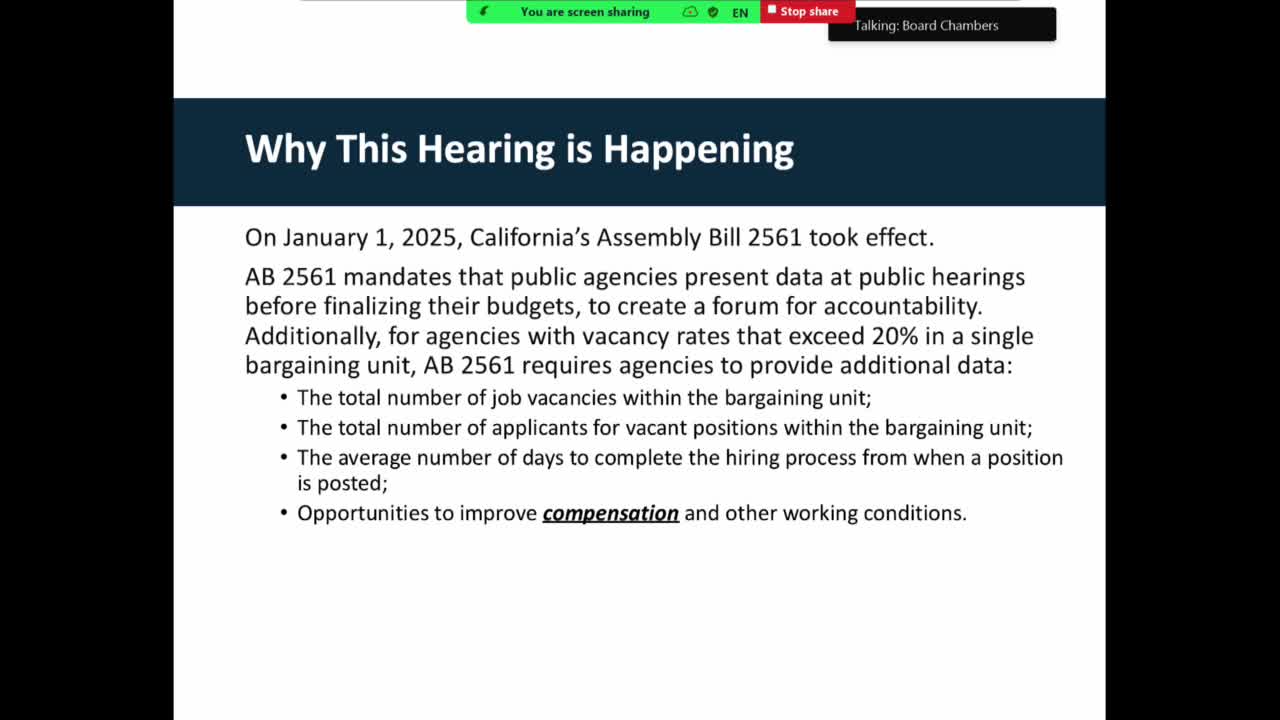Teamsters 856 critiques Marin County's flawed compensation model during employee engagement survey briefing
May 07, 2025 | Marin County, California
This article was created by AI summarizing key points discussed. AI makes mistakes, so for full details and context, please refer to the video of the full meeting. Please report any errors so we can fix them. Report an error »

The Marin County government meeting held on May 7, 2025, focused on critical issues surrounding employee compensation and retention, following the results of an employee engagement survey. The survey highlighted pay and benefits as the primary area needing improvement, prompting discussions on the county's compensation model.
Susanna, a representative from Teamsters Local 856, introduced Timothy Matthews, the research director, who presented data indicating that Marin County's cost-of-living adjustments (COLAs) have not kept pace with inflation over the past seven years, falling approximately 5.5% behind the Consumer Price Index for Urban Consumers (CPIU). Matthews emphasized the importance of total compensation, which includes take-home pay, retirement contributions, and healthcare costs, rather than just base hourly wages. He criticized the county's reliance on a median wage analysis, arguing that it does not accurately reflect the competitive landscape for employee retention.
Matthews pointed out that many employees are leaving for better-paying positions in neighboring counties, where benefits such as free family medical coverage and additional contributions to dental and vision plans are more common. He noted that Marin County's current fringe benefits do not adequately cover family healthcare costs, placing a financial burden on employees.
The discussion also touched on the county's approach to longevity pay and recruitment incentives, which Matthews argued have not been effective in addressing staffing shortages. He highlighted the negative impact of unfilled positions on employee morale and public service quality, as remaining staff face increased workloads and burnout.
In conclusion, the meeting underscored the urgent need for Marin County to reassess its compensation strategies to improve employee retention and service delivery. The county's leadership was urged to consider a more comprehensive analysis of total compensation to better align with the needs of its workforce and the competitive job market. Further discussions and potential actions are expected in upcoming meetings as the county seeks to address these pressing issues.
Susanna, a representative from Teamsters Local 856, introduced Timothy Matthews, the research director, who presented data indicating that Marin County's cost-of-living adjustments (COLAs) have not kept pace with inflation over the past seven years, falling approximately 5.5% behind the Consumer Price Index for Urban Consumers (CPIU). Matthews emphasized the importance of total compensation, which includes take-home pay, retirement contributions, and healthcare costs, rather than just base hourly wages. He criticized the county's reliance on a median wage analysis, arguing that it does not accurately reflect the competitive landscape for employee retention.
Matthews pointed out that many employees are leaving for better-paying positions in neighboring counties, where benefits such as free family medical coverage and additional contributions to dental and vision plans are more common. He noted that Marin County's current fringe benefits do not adequately cover family healthcare costs, placing a financial burden on employees.
The discussion also touched on the county's approach to longevity pay and recruitment incentives, which Matthews argued have not been effective in addressing staffing shortages. He highlighted the negative impact of unfilled positions on employee morale and public service quality, as remaining staff face increased workloads and burnout.
In conclusion, the meeting underscored the urgent need for Marin County to reassess its compensation strategies to improve employee retention and service delivery. The county's leadership was urged to consider a more comprehensive analysis of total compensation to better align with the needs of its workforce and the competitive job market. Further discussions and potential actions are expected in upcoming meetings as the county seeks to address these pressing issues.
View full meeting
This article is based on a recent meeting—watch the full video and explore the complete transcript for deeper insights into the discussion.
View full meeting
